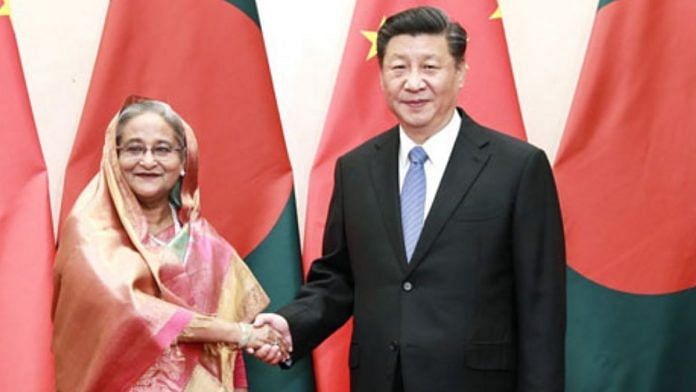The Sheikh Hasina-led Awami League government is nearing its term in Dhaka, but also readying itself to enter election mode. Recently, the Bangladesh Prime Minister inaugurated the China-built $1.2 billion six-slot submarine base, named BNS Sheikh Hasina, at Pekua in Cox’s Bazar. This project appears to be part of the Bangladesh Army’s ‘Forces Goal 2030’ programme, an ambitious defence plan that she had outlined in 2009, which seeks to expand and modernise the country’s armed forces. New Delhi has every reason to be concerned, as the base is right on the mouth of Bay of Bengal. Submarines managed by China’s People’s Liberation Army Navy—also known as PLAN—would be dangerously close to the Indian Navy’s Andaman and Nicobar Command.
The Bay of Bengal has a shallow and confined water outlet to the Indian Ocean, which requires high manoeuvrability from submarines before they can go under the water surface. This makes them vulnerable to attacks, and they can be easily drowned in the event of a conflict. So, it may not be possible for the Bangladesh Navy to use the berth for parking attack-capable submarines. Yet, it is important to note that Bangladesh, which has acquired two submarines from China, could get more of them in future and allow PLAN to use the facility under the garb of anti-piracy operations.
China’s plans for Bangladesh
In December 2002, China and Bangladesh signed a Defence Cooperation Agreement covering military training and defence production. According to Chinese government designations, Dhaka and Beijing are in a “strategic partnership of cooperation”. Bangladesh is China’s second largest defence customer. The latest report of the Stockholm International Peace Research Institute (SIPRI) on arms sold between 2016-2020 says that Bangladesh procured 17 per cent of all Chinese defence exports while Pakistan was the top customer, procuring 38 per cent of Chinese defence exports. According to the SIPRI factsheet, Beijing is the world’s fifth largest exporter of arms and weapons, accounting for 5.2 per cent of all global arms sales.
The 2002 Defence Cooperation Agreement allowed Beijing to cultivate successive governments in Dhaka as potential arms purchasers. China has steadily increased the items in its arms export list for Bangladesh. Since 2002, Bangladesh has emerged as an important element in China’s expansionist designs in South Asia. While Dhaka needs economic, trade and industrial technology to tackle its unemployment woes, Beijing has successfully convinced Bangladesh to increase its military inventory so that it can flex its muscles in the event of maritime conflicts with Myanmar, which incidentally happened in 2016. That same year, China supplied two 056 corvettes, BNS Shadhinota and BNS Prottoy to Bangladesh – each ship armed with 76 mm and 30 mm naval guns and anti-ship and surface-to-air missile systems.
Bangladesh won its maritime disputes with Myanmar in 2012 and with India in 2014. The resulting settlements allowed it to increase its sovereign claim over the Exclusive Economic Zone to about one lakh square kilometres, an area almost equal to its land mass. While India was slow to suggest a technical support mechanism for exploratory purposes, Beijing quickly supplied military and naval hardware to help Dhaka defend its newly acquired maritime resources. China also sees huge potential in arming the Bangladesh Army along the Arakanese coastline and tackling tensions emanating from illegal Rohingya settlements.
Also read: Nepal to Bangladesh, nations mounting small acts of big rebellion against China, US
What India must do
After India offered a $500 million credit line to Bangladesh in 2019—which became operationalised sometime in 2022—Dhaka showed interest in procuring military hardware items from New Delhi. This included all-terrain special purpose vehicles, helicopters and a maintenance contract for Russian-origin equipment such as Mi-17-1V helicopters, Antonov An-32 aircraft and MiG 29 jets, which India is also liberally using.
While New Delhi needs to be of use to Dhaka in the latter’s Forces Goal 2030 programme during its election year, it is important to impress upon the Bangladesh’s political establishment that it would be futile to enter into an unnecessary arms race in the region. China’s long-term plan is to cultivate South Asian countries through arms deals and deceptive trade models, which will entangle them in a debt trap and a never-ending arms race.
About 52 years after the 1971 Liberation War, a new generation of Bangladesh comprising young voters is looking for jobs, economic progress and political stability. India’s mission in Dhaka must establish contact with all sections of Bangladeshi society and its political forces to impress upon them the need to emphasise issues impacting the daily lives of the citizens.
The economic progress of Bangladesh depends on the optimum use of regional connectivity projects and the integration of Bangladesh’s economy and its military strategy into India’s Bharat Mala and Sagar Mala projects. New Delhi and Dhaka must work on Look East Act East projects more vigorously. As for India, coastline projects on the East Coast should be extended to Bangladesh and Myanmar under the broad contours of IORA (Indian Ocean Rim Association) and BIMSTEC (Bay of Bengal Initiative for Multi-Sectoral Technical and Economic Cooperation).
Seshadri Chari is the former editor of ‘Organiser’. He tweets @seshadrichari. Views are personal.
(Edited by Zoya Bhatti)



